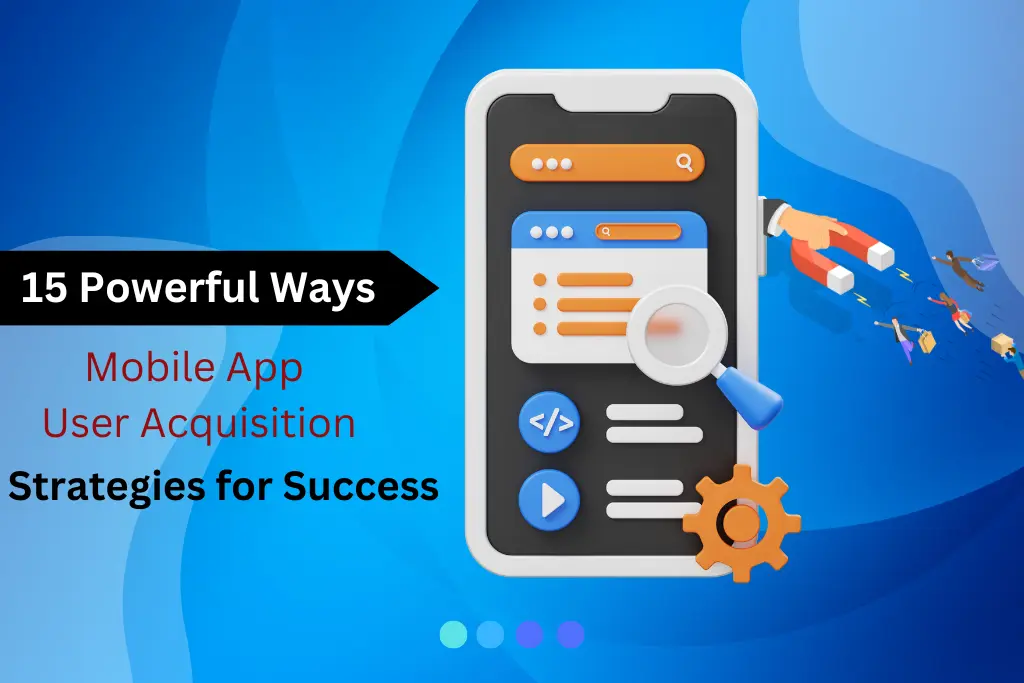Mobile App User Acquisition: Strategies and Challenges

In the vast and ever-evolving landscape of mobile applications, user acquisition stands as a critical pillar for success. In this digital age, where competition is fierce and attention spans are fleeting, the ability to attract and retain users is paramount. Let’s delve into the world of mobile app user acquisition, understanding its significance, challenges, and effective strategies.
What is User Acquisition?
User acquisition refers to the process of attracting new users to a mobile application, encouraging them to download, install, and engage with the app. It encompasses a range of marketing tactics and techniques designed to drive user adoption and conversion.
Why User Acquisition is Important
User acquisition serves as the lifeblood of any mobile app, influencing its growth, revenue, and overall success. Without a steady influx of users, even the most innovative and well-designed apps can languish in obscurity. Key reasons why user acquisition is crucial include:
Market Expansion: Acquiring new users allows the app to penetrate new markets and demographics, expanding its reach and potential user base.
Revenue Generation: More users mean more opportunities for monetization through in-app purchases, subscriptions, or advertisements.
Brand Visibility: Successful user acquisition enhances brand visibility and recognition, strengthening the app’s position in the competitive marketplace.
Feedback and Improvement: Increasing user numbers provides a larger pool of feedback, enabling developers to iterate and improve the app based on user preferences and pain points.
Common Challenges for User Acquisition
Despite its importance, user acquisition comes with its own set of challenges. Some common hurdles include:
High Competition: The oversaturated app market makes it challenging to stand out amidst the sea of competing apps.
User Retention: Acquiring users is only the first step; retaining them requires delivering consistent value and a positive user experience.
Cost Constraints: User acquisition can be costly, especially when relying on paid advertising channels, making it essential to optimize strategies for cost-effectiveness.
Changing Algorithms: Algorithms governing app store rankings and advertising platforms are constantly evolving, necessitating ongoing adaptation and optimization.
Strategies for Mobile App User Acquisition
To tackle the challenges and achieve sustainable user acquisition, app developers and marketers employ a variety of strategies. Here are 15 effective approaches:
1. App Store Optimization (ASO):
App Store Optimization (ASO) involves optimizing various elements of your app’s store listing, including the title, description, keywords, and visual assets like icons and screenshots. By strategically incorporating relevant keywords, crafting compelling descriptions, and creating eye-catching visuals, you can improve your app’s visibility in app store search results and increase the likelihood of users downloading it.
2. Social Media Marketing:
Social media marketing platforms like Facebook, Instagram, and Twitter offer vast opportunities for app promotion. Through targeted advertising, engaging content, and active community management, you can leverage these platforms to reach your target audience, drive traffic to your app’s store listing, and foster user engagement and loyalty.
3. Influencer Partnerships:
Influencer marketing involves collaborating with individuals who have a significant following and influence in your app’s niche or target demographic. By partnering with relevant influencers, you can tap into their established audience, leverage their credibility and trust, and gain exposure for your app through sponsored content, reviews, or endorsements.
4. Content Marketing:
Content marketing involves creating valuable and informative content related to your app’s niche or target audience. This can include blog posts, videos, podcasts, or infographics that address common pain points, offer solutions, or provide insights and tips. By consistently producing high-quality content, you can attract and engage potential users, establish your authority and expertise in the field, and drive traffic to your app’s website or store listing.
5. Email Marketing:
Email marketing remains a powerful tool for app promotion and user engagement. By building an email list of subscribers interested in your app or industry, you can send targeted campaigns, announcements, and updates to nurture leads, encourage app downloads, and re-engage inactive users. Personalized and well-timed emails can drive conversions and retention while providing valuable insights into user behavior and preferences.
6. Referral Programs:
Referral programs incentivize existing users to refer friends, family, or colleagues to download and use your app. By offering rewards, discounts, or exclusive perks for successful referrals, you can leverage the power of word-of-mouth marketing to expand your user base organically and encourage ongoing user advocacy and loyalty.
7. App Review Websites:
Submitting your app to reputable review websites and app directories can help increase its exposure and credibility. Positive reviews and ratings from trusted sources can instill confidence in potential users, improve your app’s search rankings, and drive organic downloads. Building relationships with app reviewers and seeking feedback can also provide valuable insights for app improvement and optimization.
8. Search Engine Marketing (SEM):
Search engine marketing involves running targeted advertisements on search engines like Google to reach users actively searching for apps or solutions related to your app’s niche. By bidding on relevant keywords and crafting compelling ad copy, you can drive qualified traffic to your app’s store listing, increase visibility, and capture users at the point of intent, driving conversions and downloads.
9. Guest Blogging:
Guest blogging on industry-related websites and publications allows you to reach a wider audience and establish your authority and expertise in your app’s niche. By contributing valuable and informative content, you can attract readers interested in your app’s topic, drive traffic back to your app’s website or store listing, and enhance your brand visibility and credibility.
10. Community Building:
Building a community around your app through forums, social media groups, or in-app communities fosters engagement, loyalty, and advocacy among users. By facilitating discussions, providing support, and soliciting feedback, you can create a sense of belonging and ownership among users, encourage user-generated content and referrals, and drive organic growth through word-of-mouth promotion.
11. Localized Marketing:
Tailoring your marketing efforts to specific geographic regions or languages allows you to resonate more effectively with local audiences and improve relevance and engagement. By understanding cultural nuances, preferences, and behaviors, you can adapt your messaging, content, and promotional strategies to better connect with users in different markets and drive downloads and conversions.
12. App Store Ads:
Investing in paid advertisements within app stores can increase your app’s visibility and exposure to users browsing or searching for apps in your category. By targeting relevant keywords, demographics, and user behaviors, you can reach potential users at the point of decision, driving installs and conversions directly from the app store.
13. Cross-Promotion:
Cross-promoting your app with other complementary apps or developers allows you to tap into each other’s user bases and expand your reach organically. By featuring each other’s apps through in-app promotions, social media shoutouts, or email newsletters, you can leverage existing relationships and credibility to drive mutual downloads and engagement.
14. Event Sponsorship:
Sponsoring relevant events, conferences, or meetups within your app’s niche or industry provides opportunities for networking, brand exposure, and user acquisition. By showcasing your app, engaging with attendees, and offering exclusive promotions or demos, you can raise awareness, generate buzz, and connect with potential users face-to-face, fostering trust and loyalty.
15. Free Trials and Freemium Models:
Offering free trials or freemium versions of your app allows users to experience its value and functionality before committing to a purchase. By removing barriers to entry and providing a risk-free way to try your app, you can attract more users, drive downloads, and encourage upgrades to premium features or subscription plans over time, maximizing revenue and retention.
Final Thoughts:
Each of these strategies offers unique opportunities for attracting and engaging users, driving downloads, and ultimately, achieving sustainable growth and success for your mobile app. By leveraging a combination of these tactics and continuously monitoring and optimizing your user acquisition efforts, you can effectively navigate the competitive app landscape and achieve your goals.
Do you Want
More App Downloads?
Boost the Mobile App Growth with the Ultimate Mobile App Marketing Experts
Latest Blogs
Do you Want
More App Downloads?
Boost the Mobile App Growth with the Ultimate Mobile App Marketing Experts
Mobile app user acquisition refers to the process of attracting new users to a mobile application, encouraging them to download, install, and engage with the app. It involves various marketing strategies and tactics aimed at increasing app visibility, driving downloads, and fostering user engagement.
User acquisition is crucial for mobile apps because it directly impacts the app’s growth, revenue, and overall success. Acquiring new users expands the app’s reach, increases revenue opportunities through in-app purchases or advertisements, enhances brand visibility, and provides valuable feedback for app improvement.
Common challenges for user acquisition include high competition in the app market, retaining users after acquisition, cost constraints associated with marketing efforts, and navigating changes in algorithms governing app store rankings and advertising platforms.
ASO involves optimizing various elements of an app’s store listing, such as keywords, descriptions, and visual assets, to improve visibility and increase organic downloads. By enhancing your app’s presence in app store search results, ASO can attract more users and drive higher conversion rates.
Influencer partnerships involve collaborating with individuals who have a significant following and influence in your app’s target audience. By leveraging their credibility and reach, influencer partnerships can help expose your app to a larger audience, drive downloads, and generate user engagement through sponsored content and endorsements.
Content marketing involves creating valuable and informative content related to your app’s niche or target audience. By producing high-quality content that addresses user needs and interests, app developers can attract and engage potential users, drive traffic to their app’s website or store listing, and establish authority and expertise in the field.
Strategies for user retention include delivering a positive user experience, providing regular updates and new features, implementing loyalty programs or rewards, and soliciting feedback to continually improve the app based on user preferences and behaviors.
App developers can measure the effectiveness of their user acquisition efforts through key performance indicators (KPIs) such as the number of downloads, user engagement metrics (e.g., retention rate, session length), conversion rates, and return on investment (ROI) from marketing campaigns. Analyzing these metrics provides valuable insights into the success of user acquisition strategies and informs future decision-making.




